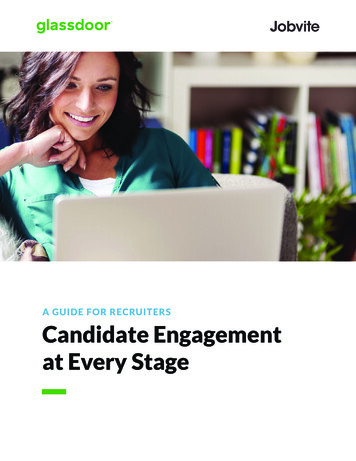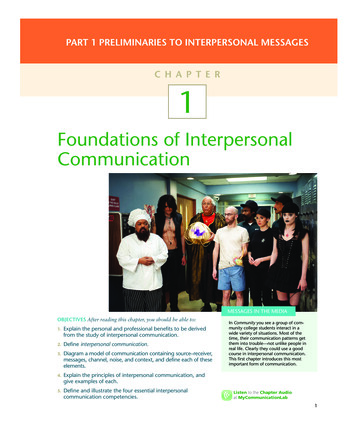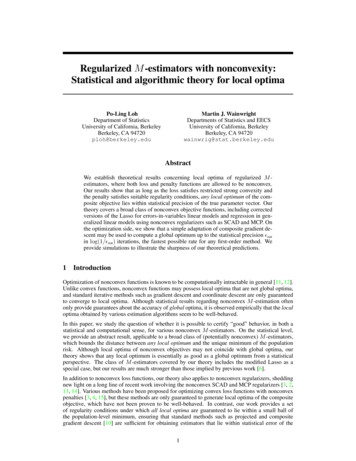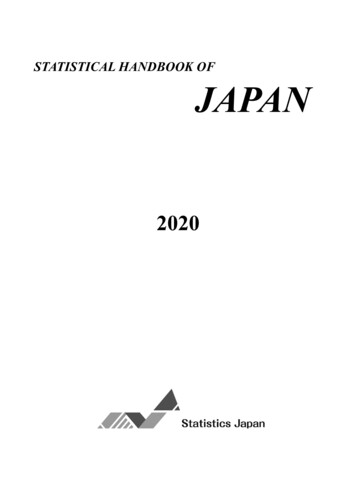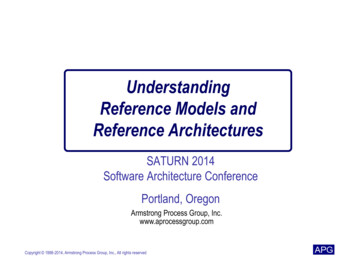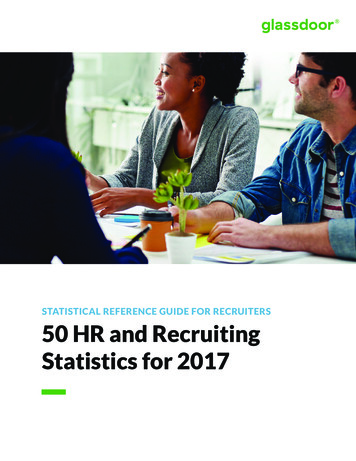
Transcription
STATISTICAL REFERENCE GUIDE FOR RECRUITERS50 HR and RecruitingStatistics for 2017
INTRODUCTIONResearch into HR topics serves a real purpose: to helpilluminate trends in the concerns and behaviors ofemployers and employees alike. These insights, whencombined with data from your company’s own analysis,can be powerful motivators for change.Our annual review of top HR and recruiting statistics fromtrend watchers like Deloitte and Gallup was augmentedin 2017 by research into Glassdoor’s own data. Inquiringinto what makes employees satisfied included analyses ofbenefits, compensation and leadership.As employers seek to find new ways of recruiting andengaging employees, the focus has turned to womenand Millennials. With women at half the U.S. populationand millennials about one-quarter,1 addressing theneeds of these workers is essential for all employers.What’s good for women and millennials is good foreveryone, so we made sure to include relevant statisticson them for each topic we addressed.We hope you’ll find a few insights in this list that help youfind and retain more of the top talent that will help growyour organization.Sources: 1 U.S. Census, 20162 50 HR and Recruiting Stats for 2017 Glassdoor, Inc. 2017
STATISTICSRecruitingAccess to company reviews, interview reviews and salaryinformation mean today’s job seeker is more prepared thanever before. Combining a respectful, thorough interviewprocess with authentic communication of your employer brandwill help attract talented candidates to your open roles.3 50 HR and Recruiting Stats for 2017 Glassdoor, Inc. 2017
STATISTICS: Recruiting1266%39%of Millennials expect to leave their organization by 2020.Source: Deloitte, Millennial Survey 2016, January 2016of women say the reputation or brand of the company is“very important” to them when considering a job move.A somewhat smaller percentage of women (32%) say the same about thecompany’s cause. For 33% of men, the company’s brand is “very important,”but only 22% feel the same about the company’s cause.Source: Gallup, Women in America, October 20163The ratio of unemployed Americans to openjobs is 1.4 to 1, compared to 6.6 to 1 duringthe last recession in July 2009.4The average opening sat unfilled for28.1 days in 2016, up from 19.3 daysin 2001-2003.2016 averagetime-to-fillOct. 2016open jobunemployed6July 2009open jobunemployedSource: Bureau of Labor Statistics, October 2016572% of CEOs are concerned about theavailability of key skills.732001-2003 averagetime-to-fill1289 10 11 12456712389 10 11 124513 14 15 16 17 18 1913 14 15 16 17 18 1920 21 22 23 24 25 2620 21 22 23 24 25 2627 28 29 30 3127 28 29 30 31Source: DHI Hiring Indicators, October 20168Source: PwC, 19th Annual Global CEO Survey, 2016Among those surveyed, the majority ofGlassdoor users read at least 7 reviewsbefore forming an opinion of a company.Source: Glassdoor.com U.S. Site Survey, August 20166Organizations that invest in employerbranding are three times more likelyto make a quality hire.9Source: Brandon Hall, The True Cost of a Bad Hire, September 20157Organizations that invest in a strongcandidate experience improve theirquality of hires by 70%.Source: Glassdoor.com Site Survey, January 201610Source: Brandon Hall, The True Cost of a Bad Hire, September 201511Glassdoor users report they use an averageof 7.6 job sites during their job search.A 10% more difficult job interview processis associated with 2.6% higher employeesatisfaction later on.Source: Glassdoor Economic Research, October 2015On a five-point scale, the optimal or “best” interview difficulty that leads tothe highest employee satisfaction is 4 out of 5, with 5 being the most difficult.Source: Glassdoor Economic Research, October 20154 50 HR and Recruiting Stats for 2017 Glassdoor, Inc. 2017
STATISTICSEngagementEmployee engagement is still a top concern for employers. Millennials’ noted job-hoppingbehavior requires employers to adopt new engagement strategies that instill workers witha sense of purpose. Glassdoor ratings and reviews offer companies a window into the driversof employee engagement, and companies who make the annual Glassdoor Best Places To WorkList serve as models for companies that wish to stay on the cutting edge — and increase profits.5 50 HR and Recruiting Stats for 2017 Glassdoor, Inc. 2017
STATISTICS: Engagement1232%35%of all U.S. employeesare engaged.29%of female employeesare engagedof Millennials are engagedSource: Gallup, Women in America, How Millennials Want to Work and Live, 201613ONLY4%of company and HR leaders believe they arevery good at engaging Millennials and othergenerations in the work environment.Source: Gallup, How Millennials Want to Work and Live, November 201614Nearly nine in ten executives (85%) rated engagement as animportant (38%) or very important (48%) priority for their companies.Source: Deloitte, Global Human Capital Trends 2016, February 201615Companies with a formal engagement strategy in place are 67% more likelyto improve their revenue per full-time equivalent on a year-over-year basis.Source: Aberdeen, The Role of Engagement in Performance Management, September 201616Boosting employee satisfaction by one Glassdoor rating point raises themarket value of a company by 7.9%.Source: Journal of Corporate Finance, 201517The average rating for a company onthe Glassdoor Best Places to Work 2017U.S. Large list is 4.3 on a 5.0 scale.The average overall rating for Glassdoorcompanies is 3.3.1886% of employees at companies on theGlassdoor Best Places to Work 2017U.S. Large list would recommend thecompany to a friend, versus 49% of totalGlassdoor users.Source for #17 and #18: Glassdoor Data Labs, October 20166 50 HR and Recruiting Stats for 2017 Glassdoor, Inc. 2017
STATISTICSLeadership andDevelopmentA key trait of strong leaders is the ability to empower others.With so many companies concerned about the leadershippipeline, investing in development opportunities and trainingfor women and Millennials will set your organization apart.7 50 HR and Recruiting Stats for 2017 Glassdoor, Inc. 2017
STATISTICS: Leadership and Development1963%Only 7% of company and HRof Millennials believetheir leadership skillsare not being fullydeveloped.leaders state that their companies haveaccelerated leadership programs forMillennials.Source: Deloitte, Global Human Capital Trends 2016, February 20162071%of Millennials likely to leave their companies in thenext two years are unhappy with how their leadershipskills are being developed — fully 17 points higherthan among those intending to stay beyond 2020.Source: Deloitte, Millennial Survey 2016, January 201621Employees who work for a femalemanager are 1.26 times morelikely than those who work fora male manager to “strongly agree”that there is someone at work whoencourages their development.24Source: Gallup, Women in America, October 20162249% of CEOs are changing theirtalent strategy to focus on theleadership pipeline so that theycan help attract, retain and engagethe staff needed to remainrelevant and competitive.Source: PwC, 19th Annual Global CEO Survey, 2016Employees who work for a femalemanager are six percentage pointsmore engaged, on average, thanthose who work for a male manager.25The three factors most stronglycorrelated to CEO approvalon Glassdoor are:1employee satisfaction2satisfaction with senior leadership3satisfaction with career opportunitiesSource: Gallup, Women in America, October 20162389% of companies see leadershipas an important or very importantissue in 2016, and 57% citeleadership as very important(up from 50% in 2015).Source: Deloitte, Global Human Capital Trends 2016, February 20168 50 HR and Recruiting Stats for 2017 Glassdoor, Inc. 2017Source: Glassdoor, What Makes a Great CEO, August 2016
STATISTICSBenefitsRising health care costs and greater attention to maternity andpaternity benefits have led many employers to reevaluate theirbenefits packages. Research shows that core benefits of healthinsurance, retirement planning and time off are still essential toemployee satisfaction, particularly for women and Millennials.9 50 HR and Recruiting Stats for 2017 Glassdoor, Inc. 2017
STATISTICS: Benefits2627Women (82%) are more likely than men (76%)to prefer new or additional benefits/perks overa pay increase, and parents who have childrenunder 18 in their household value benefits/perksover a pay increase (89%) compared to thosewithout (73%).80%of workers wouldprefer new oradditional benefitsto a pay increase.90%of those 18 to 34 yearsold (Millennials) say theywould prefer benefitsover a pay raise.NEARLY28vs.70% of those 45 to 54 years old66% of those 55 to 64 years oldSource for #26, #27 and #28: Glassdoor, Employment Confidence Survey, October 201529Rate greater work-life balanceand better personal well-beingas a “very important” attributein a new job.48% of men60% of womenFor women, work-life balanceand personal well-being aremore likely to pertain tofamily-friendly policies andflexible scheduling.Source: Gallup, Women in America, How Millennials Want to Work and Live, 20163057% of U.S. job candidates* reportbenefits and perks are amongtheir top considerations beforeaccepting a job.32Source: Glassdoor online survey conducted in the U.S. by Harris Poll, December21-23, 2015. *Job candidates are defined as employed adults or unemployedadults who are currently looking for a job3184% of employees with highbenefit satisfaction report high jobsatisfaction.Source: Guardian Life, Workplace Benefits Study, 2016Out of a list of 54 benefits,these three basic benefits showedthe highest correlation withemployee satisfaction:1health insurance2vacation/PTO3retirement planning options like401(k)s and pensionsSource: Glassdoor Economic Research, May 201610 50 HR and Recruiting Stats for 2017 Glassdoor, Inc. 2017
STATISTICSCompensationPay fairness is more important than ever, thanks to new government rules, pressinvestigations and investor requests. With information to empower them, women andMillennials are also leading the shift to salary transparency. Everyone benefits whenemployers are transparent about their approach to determining offers, giving raises andpromotional increases as well as distributing bonuses and equity.11 50 HR and Recruiting Stats for 2017 Glassdoor, Inc. 2017
STATISTICS: Compensation3368%34of women acceptedthe salary they were first offered anddid not negotiate.24.1%Men earnhigher base pay thanwomen on averageFor women age 45–54, that number was 77%.Source: Glassdoor, Demystifying the Gender Pay Gap, March 2016Source: Glassdoor, Salary Negotation Insights Survey, May 2016353670%78% of U.S. 18-to-24-year-olds(Millennials) believe salary transparencyis good for employee satisfaction,versus 64% of 45–54 year olds.of employees believesalary transparency isgood for employeesatisfaction.Source for #35 and #36: Glassdoor, Global Salary Transparency Survey, April 2016Glassdoor’s data shows a 3.1% year-over-year growthin salaries in November 2016, the fastest pace in three years.37San Francisco, Los Angeles and New York showed the largest gains.Source: Glassdoor, Global Gender Pay Gap Survey, March 20163867% of U.S. employees said theywere not likely to apply for a job ata company where men and women werepaid unequally for the same work.40Source: Glassdoor online survey conducted in the U.S. by Harris Poll,October 1-5, 2015.Source: Glassdoor, Global Gender Pay Gap Survey, March 20163995% of employees reported thatcompensation/pay was importantto their job satisfaction, but only 65%were satisfied with their compensation.49% of employed adults in the U.S.feel they must switch companies inorder to obtain any meaningful changein compensation.41Source: SHRM, Employee Job Satisfaction and EngagementReport, April 201669% of employed adults in the U.S.wish they had a better understandingof what fair market compensation is fortheir position at their company withintheir local job market.Source: Glassdoor online survey conducted in the U.S. by Harris Poll,October 1-5, 201512 50 HR and Recruiting Stats for 2017 Glassdoor, Inc. 2017
STATISTICSGlassdoorGlassdoor has become integral to the hiring process forcandidates and employers. It’s also become one of the keyways companies engage with their employees. These statswill help you understand the size, demographic makeup andinfluence of Glassdoor.13 50 HR and Recruiting Stats for 2017 Glassdoor, Inc. 2017
STATISTICS: Statistics424332 MILLIONGlassdoor hasunique monthly users, on average,to its website and mobile applications.More than half of Glassdoor’s visits eachmonth come from a mobile device.Source for #42 and #43: Glassdoor Internal Data, Q3 2016444589%of Glassdoor usersare actively lookingfor a new job orwould consider betteropportunities.36%Source: Glassdoor.com U.S. Site Survey, August 201646Source: Glassdoor.com Site Survey, January 2016Among those surveyed, nearly 1 in 10 (9%)of Glassdoor users are military veterans.49Source: Glassdoor.com U.S. Site Survey, August 20164748of Glassdoor usersare Millennials.87% of Glassdoor users find the employerperspective useful when learning aboutjobs and companies.Nearly two-thirds (65%) of Glassdoorusers agree their perception of a companyimproves after seeing an employer respondto a review.Source: Glassdoor.com U.S. Site Survey, August 2016Source: Glassdoor.com U.S. Site Survey, August 201674% of Glassdoor users are more likelyto apply to a job if the employer activelymanages its employer brand (e.g. respondsOver half of applicants to Glassdoorcustomer companies use Glassdoor.to reviews, updates their profile, shares updates onthe culture and work environment).Source: Glassdoor internal data Feb-June 2016Source: Glassdoor.com U.S. Site Survey, August 20165014 50 HR and Recruiting Stats for 2017 Glassdoor, Inc. 2017
CONCLUSIONIt’s absolutely crucial to keep yourfinger on the pulse of the constantlychanging landscape of HR topics. Bylooking closely at research and surfacingthe most pressing themes, you goa long way toward help understandingthe trends in concerns and behaviorsof employers and employees aroundbenefits, compensation and leadership.If you can leverage these insightsand marry them with data from yourcompany’s own analysis, you’ll comeout ahead in the race to find and retainmore of the top talent that will helpgrow your organization.15 50 HR and Recruiting Stats for 2017 Glassdoor, Inc. 2017
About GlassdoorWith millions of company reviews, salary reports, interview reviews and benefitsreviews on more than 640,0001 companies worldwide, Glassdoor is a trusted andtransparent place for today’s candidates to search for jobs and research companies.Glassdoor helps employers across all industries and sizes advertise their jobs andpromote their employer brands to a well-researched, highly selective candidatepool. By advertising jobs via mobile devices, email alerts and throughout Glassdoor,employers influence candidates at the moment they’re searching jobs and makingdecisions. This results in more-informed candidates that require 50% fewerresumes to find a quality hire at a fraction of the cost of traditional job boards.To stay up to date on all the latest trends in HR and recruitingsubscribe to our blogTo get involved in the conversation on Glassdoor and start managing and promoting your employer brand,email employers@glassdoor.com, call (415) 339-9105 or visit www.glassdoor.com/employers.For the latest in recruitment marketing tips, best practices and case studies, follow us on Twitter: @GDforEmployers.GlassdoorInternal Data, December2016;As measured by application-to-hire ratio compared to other job sites based on a study of 2015 hiring data for 30 million applications16Sources: 50 HRand RecruitingStats for201712 Glassdoor, Inc. 2017
availability of key skills. Source: PwC, 19th Annual Global CEO Survey, 2016 Organizations that invest in employer branding are three times more likely to make a quality hire. Source: Brandon Hall, The True Cost of a Bad Hire, September 2015 Organizations that invest in a strong candidate experience improve their quality of hires by 70%.



